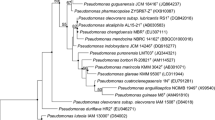Abstract
A urea-utilizing bacterium, designated Q2-2 T, was isolated from landfill. Cells of strain Q2-2 T were Gram stain-negative, aerobic, short-rod bacteria. Strain Q2-2 T was observed to grow at a temperature range of 15–37℃ (optimum 30 ℃), a pH range of 5.5–9.5 (optimum pH 8.0) and 0–4% (w/v) NaCl (optimum 1%). The major respiratory quinone was Q-8, and the major polar lipids were diphosphatidyl glycerol, phosphatidylethanolamine, phosphatidylmethylethanolamine, and phosphatidyl glycerol. Based on the 16S rRNA gene sequence, strain Q2-2 T had the highest similarity with Paracandidimonas caeni 24 T (98.0%), followed by Pusillimonas soli MJ07T (97.5%), Parapusillimonas granuli Ch07T (97.2%), Pusillimonas ginsengisoli DCY25T (97.1%) and Paracandidimonas soli IMT-305 T (96.4%). The ANI values between strain Q2-2 T and the above related type strains were 71.02%, 73.52%, 74.32%, 74.59% and 72.29%, respectively. The DNA G + C content of strain Q2-2 T was 61.1%. Therefore, strain Q2-2 T represents a novel species of the genus Paracandidimonas, for which the name Paracandidimonas lactea sp. nov. (type strain Q2-2 T = CGMCC 1.19179 T = JCM 34906 T) is proposed.


Similar content being viewed by others
Abbreviations
- ANI:
-
Average nucleotide identity
- DPG:
-
Diphosphatidyl glycerol
- PE:
-
Phosphatidylethanolamine
- PME:
-
Phosphatidylmethylethanolamine
- PG:
-
Phosphatidyl glycerol
References
Aziz RK et al (2008) The RAST Server: rapid annotations using subsystems technology. BMC Genom 9:75–75. https://doi.org/10.1186/1471-2164-9-75
Chun J et al (2015) OrthoANI: an improved algorithm and software for calculating average nucleotide identity. Int J Syst Evol Microbiol 66:1100. https://doi.org/10.1099/ijsem.0.000760
Cowan ST, Steel KJ, Mccoy E (1966) Manual for the identification of medical bacteria. Proc R Soc Med 59:468. https://doi.org/10.1111/j.2042-7158.1965.tb07589.x
Elizabeth et al (2012) Scanning electron microscopy. Curr Protoc Microbiol. https://doi.org/10.1002/9780471729259.mc02b02s25
Fitch WM (1971) Toward defining the course of evolution: minimum change for a specific tree topology. Syst Zool. https://doi.org/10.2307/2412116
Fitch WM, Margoliash E (1967) Construction of phylogenetic trees. Science 155:279–284. https://doi.org/10.1126/science.155.3760.279
Glaeser SP, Kämpfer P (2015) Multilocus sequence analysis (MLSA) in prokaryotic taxonomy. Syst Appl Microbiol 38:237–245. https://doi.org/10.1016/j.syapm.2015.03.007
Gomorie G (1955) Preparation of buffers for use in enzyme studies. Methods Enzymol 1:138–146. https://doi.org/10.1016/0076-6879(55)01020-3
Joseph F (1981) Evolutionary trees from DNA sequences: a maximum likelihood approach. J Mol Evol 17:368–376. https://doi.org/10.1007/BF01734359
Jun-Lian et al (2016) Filimonas zeae sp. nov., an endophytic bacterium isolated from maize root. Int J Syst Evol Microbiol 66:2730–2734. https://doi.org/10.1099/ijsem.0.001116
Kämpfer P et al (2017) Paracandidimonas soli gen. nov., sp. nov., isolated from soil. Int J Syst Evol Microbiol 67:1740–1745. https://doi.org/10.1099/ijsem.0.001852
Kim YJ et al (2010) Parapusillimonas granuli gen. nov., sp. nov., isolated from granules from a wastewater-treatment bioreactor. Int J Syst Evol Microbiol 60:1401–1406. https://doi.org/10.1099/ijs.0.009720-0
Kuykendall LD et al (1988) Fatty acids, antibiotic resistance, and deoxyribonucleic acid homology groups of Bradyrhizobium japonicum. Int J Syst Bacteriol. https://doi.org/10.1099/00207713-38-4-358
Lee M et al (2010) Pusillimonas soli sp. nov., isolated from farm soil. Int J Syst Evol Microbiol 60:2326–2330. https://doi.org/10.1099/ijs.0.020404-0
Li Y et al (2018) Paracandidimonas caeni sp. nov., isolated from sludge. Int J Syst Evol Microbiol 69:3332–3337. https://doi.org/10.1099/ijsem.0.003131
Meier-Kolthoff JP et al (2013) Genome sequence-based species delimitation with confidence intervals and improved distance functions. BMC Bioinf 14:60. https://doi.org/10.1186/1471-2105-14-60
Saitou N, Nei M (1987) The neighbor-joining method: a new method for reconstructing phylogenetic trees. Mol Biol Evol 4:406–425. https://doi.org/10.1093/oxfordjournals.molbev.a040454
Sasser M (1990) MIDI technical note 101. Identification of bacteria by gas chromatography of cellular fatty acids. MIDI, Newark
Shen X et al (2018) Polyphasic taxonomic characterisation of a novel strain as Pararhizobium haloflavum sp. nov., isolated from soil samples near a sewage treatment tank. Antonie Van Leeuwenhoek 111:485–491. https://doi.org/10.1007/s10482-017-0969-5
Srinivasan S et al (2010) Pusillimonas ginsengisoli sp. nov., isolated from soil of a ginseng field. Int J Syst Evol Microbiol 60:1783–1787. https://doi.org/10.1099/ijs.0.018358-0
Su Y et al (2016) Thalassobaculum fulvum sp. nov., isolated from deep seawater. Int J Syst Evol Microbiol 66:2186–2191. https://doi.org/10.1099/ijsem.0.001008
Sudhir K et al (2018) MEGA X: molecular evolutionary genetics analysis across computing platforms. Mol Biol Evol 35:1547–1549. https://doi.org/10.1093/molbev/msy096
Tindall BJ (1990) Lipid composition of Halobacterium lacusprofundi. FEMS Microbiol Lett. https://doi.org/10.1016/0378-1097(90)90282-U
Weisburg WG et al (1991) 16S ribosomal DNA amplification for phylogenetic study. J Bacteriol 173:697–703. https://doi.org/10.1128/jb.173.2.697-703.1991
Yoon SH et al (2017) Introducing EzBioCloud: a taxonomically united database of 16S rRNA gene sequences and whole-genome assemblies. Int J Syst Evol Microbiol 67:1613–1617. https://doi.org/10.1099/ijsem.0.001755
Funding
This research is supported by The Key Research and Development Project of Zhejiang (Grant No. 2020C02030; 2021C02039) and Shanxi (Grant No. 2019TSLSF02-01-01) Provinces, The Open Project of Zhejiang Provincial Key Laboratory of Agricultural Green Biomanufacturing Core Strain Improvement (Grant No. 2020KFKT09), Zhejiang Provincial Natural Science Foundation of China (Grant No. LQ20C010006).
Author information
Authors and Affiliations
Contributions
X-fH and CS: designed the research and project outline. CZ, QP, J-jY, H-tW, YC and G-hZ: performed isolation, deposition and identifcation. CZ, C-zL, B-jW, Y-hZ and OL: performed fatty acids analysis. All authors read and approved the final manuscript.
Corresponding authors
Ethics declarations
Conflict of interest
The authors declare that there are no conflicts of interest.
Ethical approval
This article does not contain any studies with human participants or animals performed by any of the authors.
Additional information
Communicated by Erko Stackebrandt.
Publisher's Note
Springer Nature remains neutral with regard to jurisdictional claims in published maps and institutional affiliations.
Supplementary Information
Below is the link to the electronic supplementary material.
Rights and permissions
Springer Nature or its licensor holds exclusive rights to this article under a publishing agreement with the author(s) or other rightsholder(s); author self-archiving of the accepted manuscript version of this article is solely governed by the terms of such publishing agreement and applicable law.
About this article
Cite this article
Zhang, C., Pu, Q., Ying, Jj. et al. Paracandidimonas lactea sp. nov., a urea-utilizing bacterium isolated from landfill. Arch Microbiol 204, 633 (2022). https://doi.org/10.1007/s00203-022-03190-4
Received:
Revised:
Accepted:
Published:
DOI: https://doi.org/10.1007/s00203-022-03190-4




